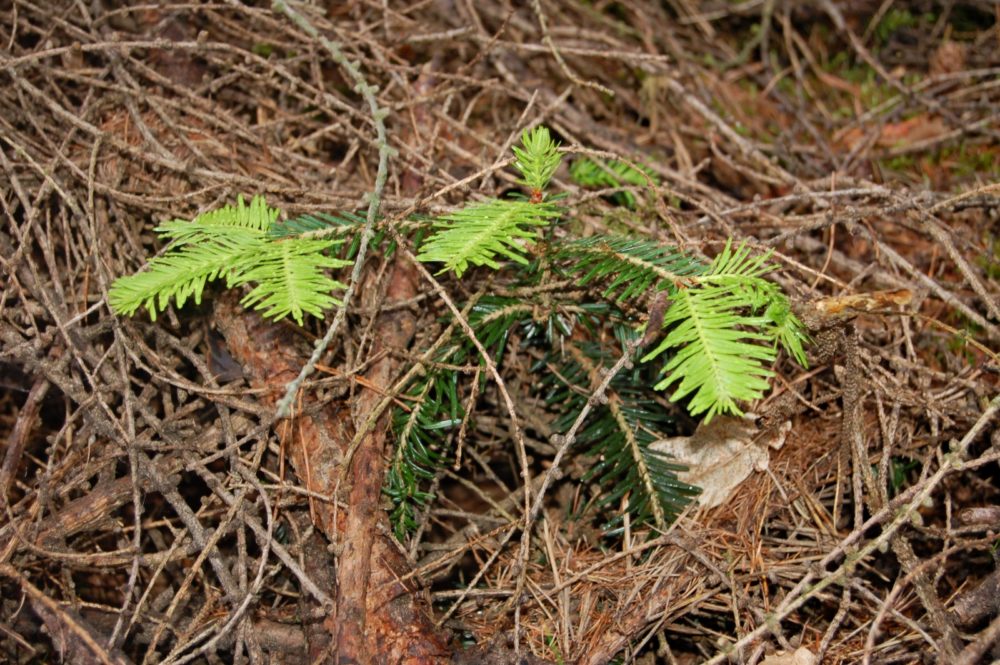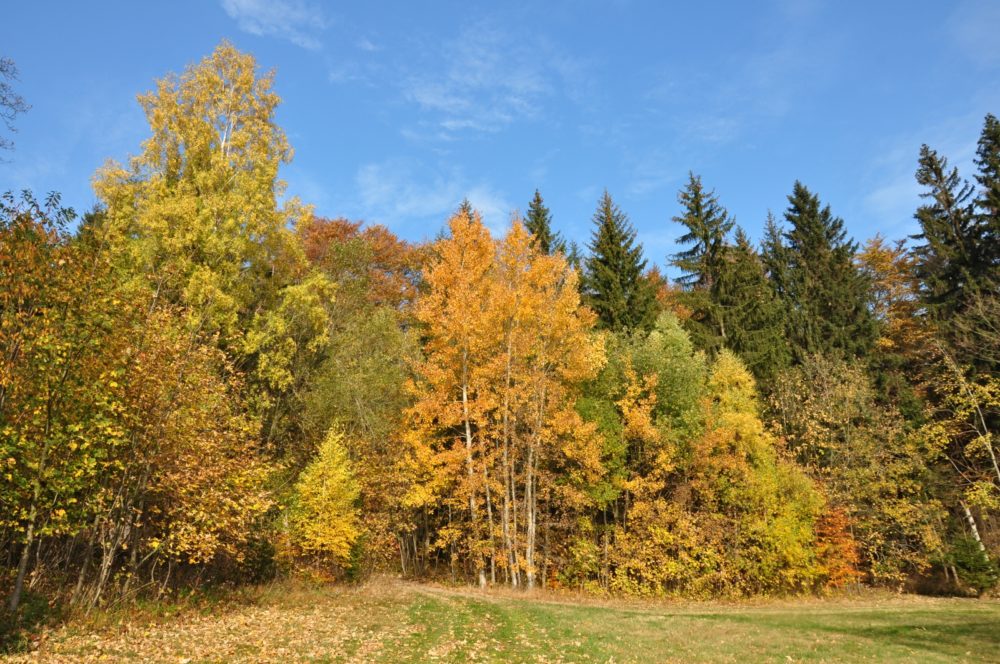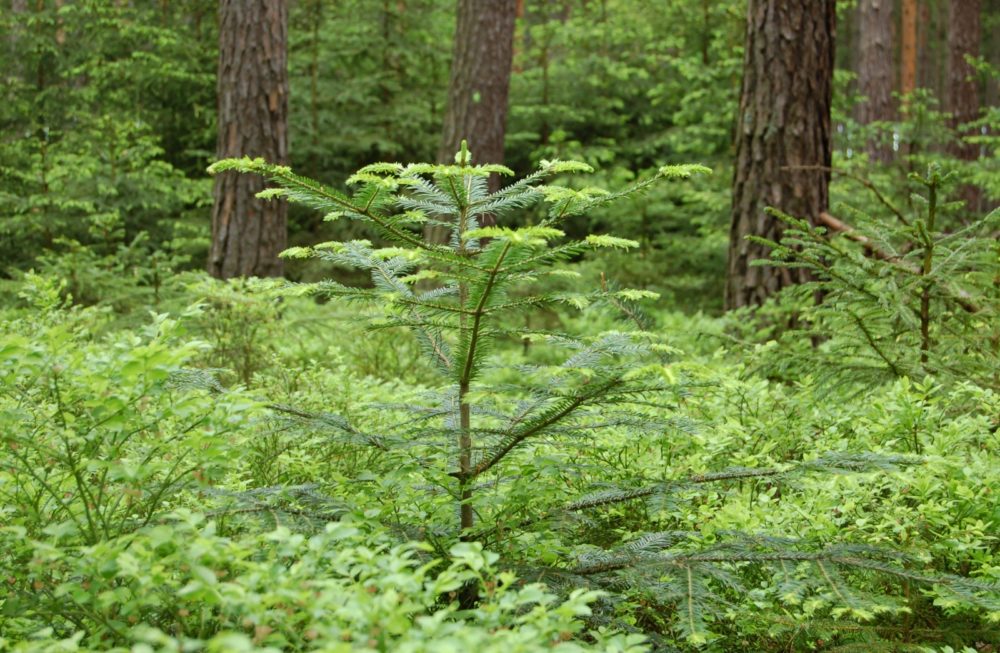What about the “pioneer character” of silver fir?
Silver fir used to be an important tree species in our forests in the past. However, due to various factors, its population gradually decreased to the current 1.2%. It was mainly preserved in mature stands with less favourable conditions for spruce growth or in areas where planting spruce was limited by ownership conditions, such as in cooperative or agricultural forests.
 At the start of the 21st century, a spruce dieback occurred in north-eastern Moravia and Silesia, affecting both pure spruce forests and mixed forests with spruce.
At the start of the 21st century, a spruce dieback occurred in north-eastern Moravia and Silesia, affecting both pure spruce forests and mixed forests with spruce.
Photo: Natural regeneration of silver fir. Author Jan Řezáč
Private forests, from which the spruce disappeared, were often neglected by the new owners and state forest administration due to ongoing restitution. In contrast, cultural spruce forests, particularly those owned by the state, were swiftly restored with targeted trees after they disappeared.
Improper and excessive restoration treatments often lead to the establishment of new forests dominated by pioneer tree species. Other tree species like fir, pine, and beech managed to survive with varying degrees of vitality along the clearings or within the resulting thinnings. It is now common to find forests that are more than thirty years old but with a majority of pioneer trees in their upper etage.
In the forestry practice, pioneer tree species are utilized to create new stands in open areas, known as preparatory stands. Additionally, these pioneer species can also be grown as target tree species. Long-term research has shown that pioneer tree species have a positive impact on the growth of target tree species, as long as proper silviculture procedures are followed.
Despite various optimal silviculture techniques for pioneer tree species, uncertainties remain on using natural processes for forest regeneration after disturbances (calamities).
Scientists from the Mendel University in Brno, Faculty of Forestry and Wood Science focused on this topic. They presented the first results of their research in the paper „Spontaneous regeneration of silver fir under aspen dominated stands (Spontánní obnova jedle bělokoré pod porosty s převahou topolu osiky), which was published in the journal Reports of Forestry Research 3/2023.
 Their objective was to determine, through field investigations in selected post-disaster areas in Nízký Jeseník Mts., methods of silviculture fir tree species that are closer to nature. They also analyzed the structure of the upper level of selected pioneer tree species stands. Additionally, they described the structures of the natural regeneration of fir, and the current state of recovery of other tree species, and identified the extent of damage to the wildlife’s recovery.
Their objective was to determine, through field investigations in selected post-disaster areas in Nízký Jeseník Mts., methods of silviculture fir tree species that are closer to nature. They also analyzed the structure of the upper level of selected pioneer tree species stands. Additionally, they described the structures of the natural regeneration of fir, and the current state of recovery of other tree species, and identified the extent of damage to the wildlife’s recovery.
Photo: Admixture of aspen in the forest edge. Author Jan Řezáč
The researchers selected two specific areas named “Padělky” and “Mokřinky” in Nízké Jeseník for their study. They chose these areas based on their structure, which included a prevalence of aspen trees on the upper floor, an age of around 30 years, and the presence of mature fir trees in the immediate vicinity.
Both of the selected areas were dominated by aspen trees, with representations of 56% and 74% respectively. However, fir trees were the main species in both areas for natural regeneration, with a representation of 73% and 65% respectively. The regeneration of fir trees in both areas was found in a wide range of ages, from one to more than ten years old. Both areas also suffered considerable damage to fir trees by game, with 14% and 18% of the trees affected in “Padělky” and “Mokřinky” respectively.
Scientists predict that the future growth of fir trees will be influenced by competition from other species, especially beech trees in the “Mokřinky” area and hornbeam trees in the “Padělky” area.
The current state and structure of both stands are due to the death and decay of non-native spruce trees, as well as the return of private property in the early 1990s. Unfortunately, neither stand received proper restoration after the calamity, resulting in clearings left without any further intentional intervention.
However, the structure of the stands indicates the potential for natural succession to restore the forest under the given habitat conditions, representing the nutrient habitats of the 3rd forest vegetation stage.
 Due to the fact that no intentional silvicultural intervention was carried out in the stands, their structure is the result of only natural processes – succession and auto reduction. Their species composition is then the result of the disturbance regime, the structure of the original and surrounding stands, and habitat conditions.
Due to the fact that no intentional silvicultural intervention was carried out in the stands, their structure is the result of only natural processes – succession and auto reduction. Their species composition is then the result of the disturbance regime, the structure of the original and surrounding stands, and habitat conditions.
Photo: Natural regeneration of silver fir. Author Jan Řezáč
After their formation, the pioneer forest areas have been seeing an increase in the presence of silver fir. Unfortunately, the growth and revival of these long-lived tree species in the pioneer forests are limited due to wildlife. Game pressure reduces the chances of successful establishment of silver fir trees and negatively affects their competition with other woody species.
Although the game has a strong inhibitory effect, the scientists’ findings confirm the hypothesis that the high prevalence of silver fir in many locations in the Czech Republic and Central Europe is linked not only to disturbances, but also to human activity. The study results provide further insight into how the colonization of fir trees on abandoned agricultural land might have occurred in the past.
The silver fir has a slow growth rate at an early age, making it unable to colonize bare areas due to strong weed competition. However, it can effectively regenerate in the cover of pioneer trees.
Research has also shown that areas where fir has expanded at the expense of beech have a high proportion of pioneer trees. Furthermore, it is known and documented that former agricultural lands have a high potential for pioneer tree species and their spontaneous regeneration.
The model mentioned for the spontaneous renewal and spread of silver fir, with the participation of pioneer tree species, provides valuable insights into the concept of the “pioneer character of silver fir”.
However, an unanswered question remains regarding the long-term survival of fir and other tree species, primarily European beech, during the times of climate change.
The paper „Spontaneous regeneration of silver fir under aspen dominated stands“ (Spontánní obnova jedle bělokoré pod porosty s převahou topolu osiky) can be downloaded here.
Autoři článku: Antonín Martiník, Jiří Krásenský, Mendelova univerzita v Brně, e-mail: antonin.martinik@mendelu.cz
Prepared by: Ing. Jan Řezáč, FGMRI (VÚLHM, v. v. i.), e-mail: rezac@vulhm.cz
